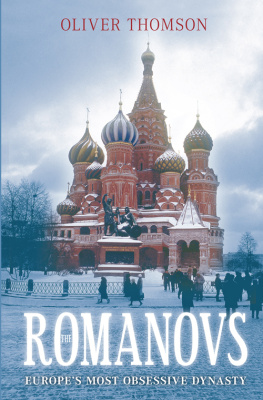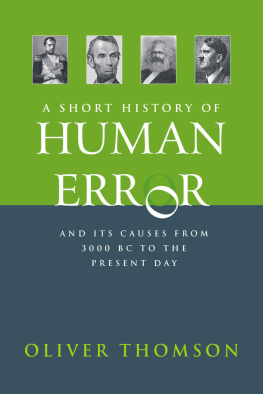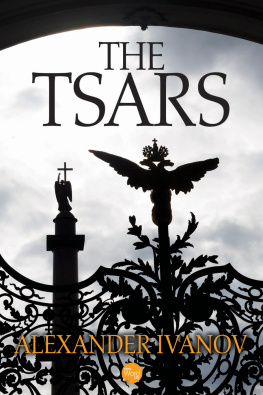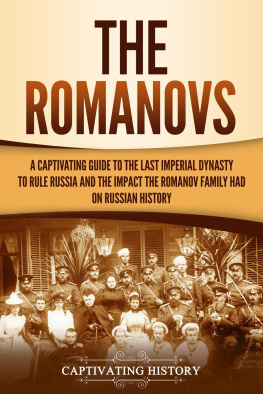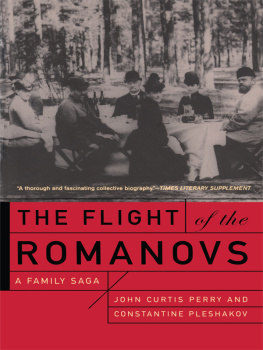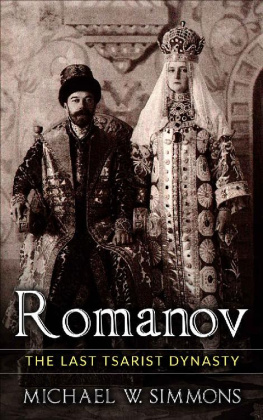
We have taught ourselves to ridicule all our past: we never acknowledge a good deed or a good intention in our history
Alexander Solzhenitsyn, The Gulag Archipelago
Unfortunate things often happen to Russian sovereigns
The Emperor Pauls mother-in-law
CONTENTS
I |
II |
III |
IV |
V |
VI |
VII |
VIII |
I |
II |
III |
IV |
V |
VI |
VII |
VIII |
IX |
X |
XI |
XII |
XIII |
XIV |
MAPS
1 Russian expansion from Ivan IV to Catherine the Great
2 Russian expansion from Catherine the Great to Nicholas II
3 Historic Moscow
4 Historic St Petersburg
BLACK AND WHITE ILLUSTRATIONS
1 Peter I strikes one of the Streltsi in the face
2 Peter at fifty
3 Peter with Catherine on the Neva
4 Catherine II
5 Paul
6 Alexander I
7 Nicholas I
8 The coronation of Alexander II
9 Alexander III
10 Nicholas II
11 Tsarevitch Alexis
12 Rasputin
13 Alexandra
14 Child victims of a pogrom in the Ukraine
COLOUR ILLUSTRATIONS
Moscow
1 St Basils Cathedral
2 Tsar Feodors cannon
3 Trinity Tower
4 Annunciation Cathedral and Great Kremlin Palace
5 Bolshoe Theatre
6 Cathedral of Assumption and Palace of Facets
7 Bell Tower and Kremlin Wall
St Petersburg
8 The Bronze Horseman
9 Peter and Paul Fortress
10 Peterhof Cascade
11 The Winter Palace faade
12 The Winter Palace interior
13 Smolny Institute
14 Pavlovsk and statue of Tsar Paul
15 Spilt Blood Cathedral
16 The Cruiser Aurora
Of the black and white illustrations, 1-12 are from the authors private collection.
For the colour pictures I am indebted for 1 to my son-in-law Neil Sutherland and for the remainder to my old friend Lawrie Taylor.
For tolerance I am indebted to my long-suffering wife.
The Romanovs were from the start in many ways a very dysfunctional family yet for several centuries they dominated what became the largest nation in Europe. Their incredible self-belief, their obsession with absolute control, their addiction to savage punishment, their self-indulgence and hedonism, their carelessness with human life and later their sheer incompetence caused enormous suffering. Their obstinacy cost millions of lives, particularly when they played a key role in starting the First World War, then wantonly exposed their massive but ill-prepared armies for slaughter. This book examines the extraordinary psychology of the leaders of this dynasty, their remarkable ability to survive major disasters, the strong and talented women they chose as wives and produced as daughters. They were not only an eccentric dynasty but their leading members were eccentric in remarkably different ways: from feeble, monk-like characters such as Tsar Mikhail to the workaholic giant Peter the Great or the hen-pecked mediocrity, Nicholas II.
The rewards for those members of the family who won the throne were enormous in terms of wealth and, if they had the character to wield it, almost unlimited power. Yet such was their sense of duty that they made great personal sacrifices for what they believed was right. The price of failure was also very high: for the men it often meant murder six out of their eighteen crowned heads met violent ends or imprisonment in remote fortresses for the rest of their lives; for the women it meant the dangers of frequent child-bearing, of compulsory incarceration in a nunnery or years of neglect as they had no choice but to tolerate the open adultery of their husbands.
Partly due to ill health and partly due to violence the average life-span of ruling Romanovs was not high: their average age at death was forty-four. Only two lived beyond the age of sixty, Catherine the Great (sixty-seven) and Alexander II (sixty-two) and none of them made it to seventy. The average length of reign was only seventeen years with Peter the Great having the longest forty-three years six others lasting five years or less.
Each chapter is a stand-alone mini-biography of each head of the family, so in terms of chronology there is some back-tracking, but that is because this book is more an analysis of character than a history of Russia. At the same time there is a thread running through all the lives, for each generation introduced variations on the theme of compulsive autocracy which cumulatively created an inheritance that made any softening dangerous, if not impossible, and led inevitably towards disaster.
The third main section of the book takes us on an armchair trip round the vast Russian empire which spread into areas which are now part of China and the United States as well as Poland, Finland, the Baltic States and a whole clutch of central Asian republics. Here we look at the extraordinary architectural legacy of a dynasty that did nothing by halves.
NOTE ON SPELLING
It is difficult to arrive at a style of spelling Russian names in our alphabet which is at once consistent, easily readable and true to the beauty of the Russian language. Some of the main characters in this book are so well known by their anglicised form of name like Peter or Nicholas that it seems pedantic to call them Pyotr or Nikolai, let alone Yekaterina for Catherine, whereas since the days of Gorbachev we have become used to Mikhail for Michael. Similarly we are well used to Tchaikovsky in concert programmes with a T and why change the final y to a double i? We are used to Moscow not Moskva, Crimea not Krim. Tartar is easier to say that Tatar. Odesa is more up to date than Odessa. Thus I have not been entirely consistent but have included a short glossary at the back of the book which lists those Russian words and names used with alternative spellings, especially those place names like St Petersburg that have been changed by different governments. I have also been slightly more pedantic in the gazeteer section so that people can find their way around.
NOTE ON CALENDAR
I have generally avoided complications due to the difference between the Julian and Gregorian calendars, though occasionally it does have some significance like the October/November revolution of 1917.
REFERENCES
Footnotes have not been included but wherever a source or writer is mentioned or quoted the details of the work referred to are included in the bibliography.
PART ONE
I
If they had not separated me from my little heiffer there would not have been so many victims
Letter from Ivan IV to Prince Kurbsky
In February 1547 in the Cathedral of the Annunciation in the Kremlin, Moscow, the seventeen-year-old Ivan IV, the first ruler of Muscovy officially to be given the title Tsar, married his teenage bride Anastasia. Both his new title and his choice of bride were to be of great significance in the centuries that followed.
His new title Tsar, or Czar, was the russianised form of Caesar, first borrowed informally by his grandfather Ivan III after the fall of two great cities had presented him with a unique opportunity. The capture by the Turks of Constantinople, known as the Second Rome, meant that Moscow could put itself forward as the Third Rome and one that would last for ever. The other city was Kiev which had been captured first by the Tartars, then the Poles, which meant that Moscow had a claim to be the capital of the Russian Orthodox Church. Put the two concepts together and the Grand Princes of Muscovy could justifiably call themselves Caesar. They could also start promoting Moscow as the new capital of the Christian world.
Next page
